by Jill & Sarah | Apr 12, 2020 | 2nd/3rd Grade News

La Lectura y las matemáticas
This week we are going to have Whole Group lessons on Mondays and Fridays at 1:00.
On Monday the class will discuss dividing into smaller groups for Zoom meetings on Tuesdays and Thursdays. The groups times for Math Zoom Meetings on Tuesdays and Thursdays will be:
1:00-1:30 1:35-2:05 2:10-2:40 2:45-3:15
We will have 4 students in each math session. Meeting information will be the same.
I will also have an open hour on Wednesdays 1:00-2:00 for anyone who has questions or needs help. (I will post the meeting information each Wednesday.)
We continue to read, acquiring new vocabulary and new awareness of sentence structures. Please ask your child to retell you their story. Retelling has SO much value. The importance of retelling stories is that it allows students to learn to organize and describe events, which enhances reading comprehension. … Retelling stories helps language learners begin to understand sequence, plot, and characterization as they build vocabulary and comprehension skills.
Weekly writing assignments allows students to use their vocabulary, grammar and language awareness in context, while asking them to create something new.
Our math objectives this week will be:
- use bar models to solve two-step word problems
- choose the correct operation to solve two-step word problems
- review and test on all concepts learned so far
Science
This week our science objectives will be to:
~Explain why nature ad ecosystems are not static but are constantly changing
~Describe the balance of nature in an ecosystem
~Explain how changes in an ecosystem are caused by natural events and by humans
~Explain why animals must leave their habitat when natural balance is lost
Explain how ecosystems are affected by changes in the environment
History and Geography
This week our history goal will be to:
Work cooperative in pairs to research an European explorer and present their findings to the class on Friday. They will research the following:
Where and when the explorer was born?
What country did the explorer sail for?
What were they trying to find?
Information on their voyages: name of ships, dates, what did they actually find, how many voyages, route/s they took
What is the most important thing that came from their exploration
Any additional and/or interesting information
Draw a picture of the explorer and/OR dress up as that explorer for the presentation on Friday
by Jill & Sarah | Apr 5, 2020 | 2nd/3rd Grade News
Spring Break
April 6- April 10 is our Spring Break. We won’t be assigning new work during this week but will continue to have our Zoom meetings as a way to stay connected. Students can continue to work through things in the Google Classroom as they find they have extra time.
Happy Easter!
Daily Schedules
We thought it might be helpful to provide a breakdown of our day. Here is a basic checklist of what your child should continue working on each day.
English in the morning and Spanish in the afternoon.
There are many other learning opportunities listed in Google Classroom.
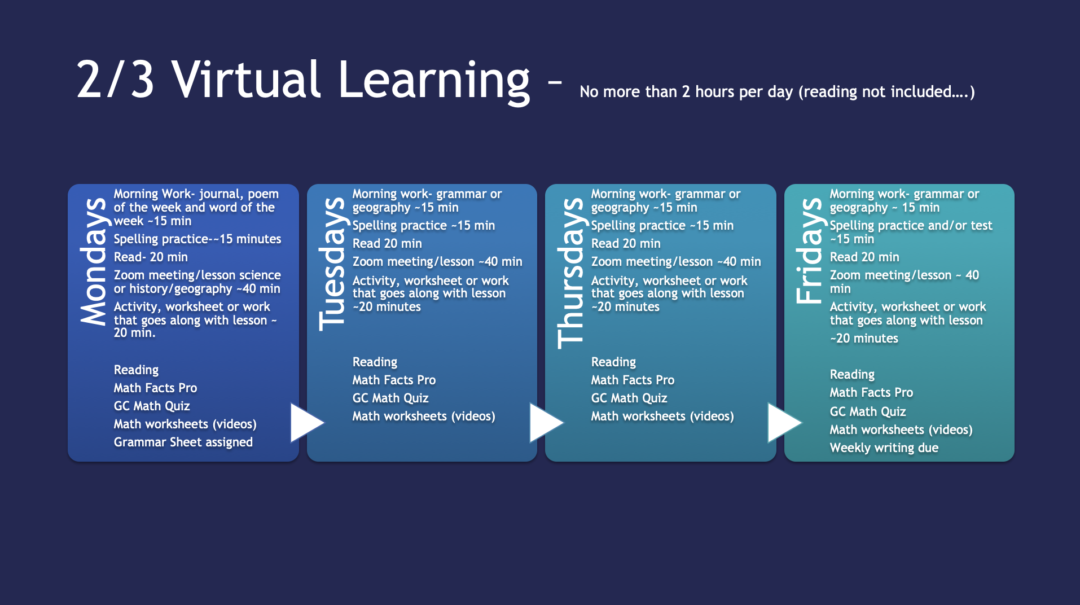
We have created a weekly schedule that acts as a checklist for the students to “color” as they work through their week. We will post that schedule after spring break. Here’s what it looks like: (The links in this picture are not active.)
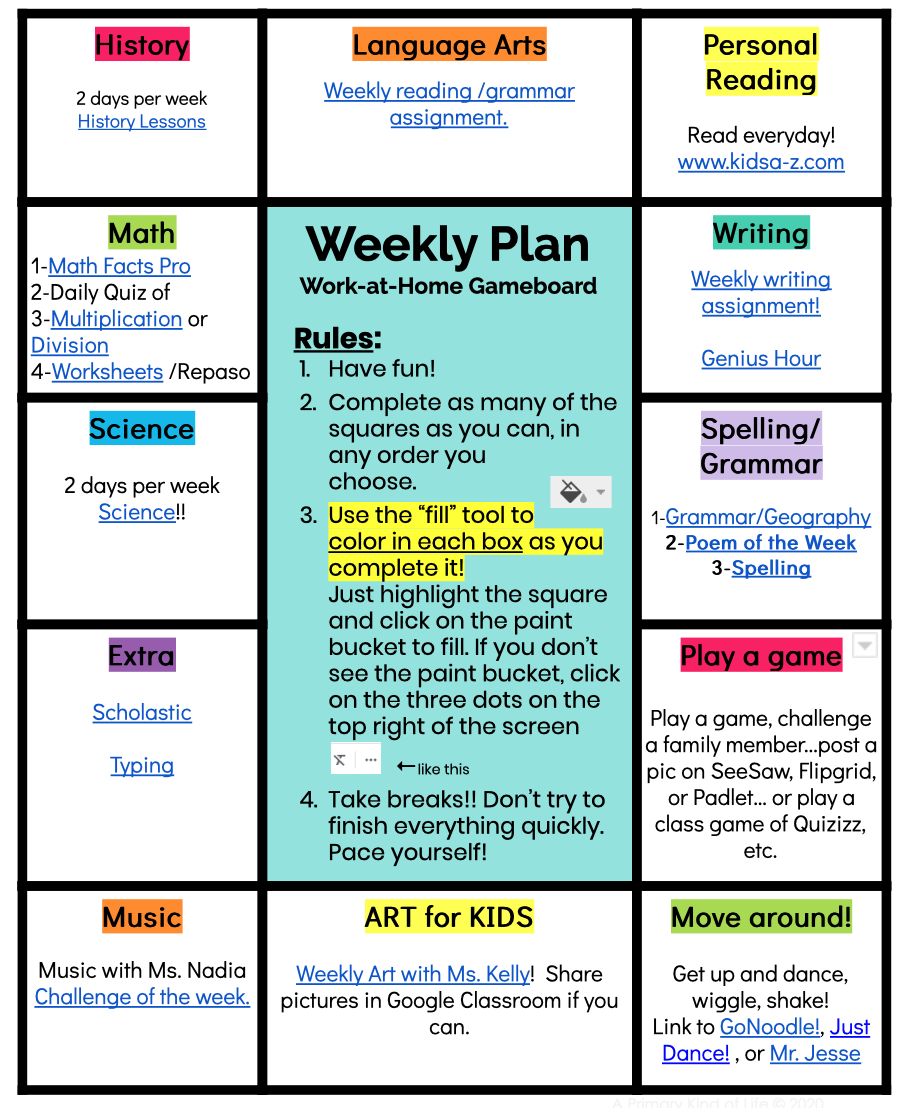
Students will have their own copy each week and can “color” in each square as they complete it. The links in each square take them straight to the assignment in their Google Classroom. No more searching around!
Have a very happy Easter and a great spring break!
![]()
![]()
by Jill & Sarah | Mar 29, 2020 | 2nd/3rd Grade News
La Lectura
Our learning objectives for week 28 will be:
- Read EVERY day. Talk about what they are reading.
- Form sentences with different verbs (checking on noun-verb agreement) (Worksheet: Ruleta de Verbos)
- Complete a Google Slide paragraph writing assignment to describe a picture. (Verbs, Capitalization, punctuation, spelling, accents, adjectives).
- Kidsa-z.com Record themselves reading the assigned reading. Retell the story in their own words (record this too). Answer comprehension questions.
- Read: Piel de gallina (worksheet). More than once. Answer comprehension questions in complete sentences. (Mark where you found your answer in the story by putting the question #.)
- Create an Adjective chart/poster/Google Slide/ page in your Lectura notebook. (12-20 adjectives)
- Use adjectives to be more descriptive in speech and writing.
Las matemáticas
Learning objectives:
- Solidify math facts (addition, subtraction, multiplication, division) through daily practice (mathfactspro.com or flashcards)
- Daily math facts quiz on Google Classroom
- Use bar models to solve two-step word problems.
- Choose the correct operations to solve two-step word problems.
- Daily review (green packet). Check their answers against mine in Google Classroom.
Science
This week our learning goals will be to:
*Explain my nature and ecosystems are not static that are constantly changing.
*Describe the balance of nature in an ecosystem.
*Explain how changes in an ecosystem are caused by natural events and by humans.
*Explain why sometimes animals must leave their habitats when the natural balance is lost.
*Explain how ecosystems are affected by the changes in the environment.
History & Geography
This week our learning objectives will be to:
*Describe North America’s geography, including the following locations: Canada, Newfoundland, and the Hudson river.
*Summarize the attempts of Cabot and Hudson to find the Northwest passage.
*Describe Cabot’s and Hudson’s explorations.
*Understand the meaning of the following Vocabulary: merchant, trading center, fleet, northwest passage, and mutiny.
by Jill & Sarah | Mar 22, 2020 | 2nd/3rd Grade News
Here are the learning objectives for your child for next week.
(All links for their assignments are located in the Google Classroom.)
Zoom Meetings scheduled with Ms. Jill – 10:00 Mondays, Tuesdays, Thursdays, Fridays
Zoom Meetings scheduled with Maestra Sarah – 1:00 Mondays, Tuesdays, Thursdays, Fridays
We will see how this goes this first week. Please provide feedback to let us know how it’s going!
La Lectura
- Read daily. kidsa-z.com or books from home
- Assigned librito: #16 Bienvenidos al gran desfile (we will read together and discuss in Zoom)
- Identify subjects, verbs, adjectives in book #16 (we will discuss and asking in Zoom and Google Classroom)
- Free write in their journal (cuaderno rojo – red journal)
- One Weekly Writing prompt (cuaderno rojo – red journal)
- Subject -Verb sentence practice – Workheet: Búsqueda de oraciones and Ruleta de verbos
- Create an adjective poster (or journal entry if you don’t have poster board or big paper). They can look up adjectives they want to use. They will share this during a Zoom meeting and then use their adjectives in their journals.
Las matemáticas
- Complete a daily multiplication quiz (I’m working on getting Division up and running but they could time themselves to get faster!)
- MathFactspro.com
- Complete a daily review sheet (from the packet sent home) before our 1:00 Zoom meeting.
- Math journal: Problems of the day (Zoom)
- Introduction to Bar Models: Multiplication and Division (Zoom and worksheets)
Science
This week our goals will be to:
- Describe and provide an example of a habitat
- Explain why certain organisms live in certain habitats and how they adapt to those habitats
- Describe and provide an example of an ecosystem
- Describe how organisms in an ecosystem depend on each other and their environment
- Describe what happens in a food chain
- Classify members of a food chain as producers, consumers, or decomposers
- Explain why nature and ecosystems are not static that are constantly changing
- Describe the balance of nature in an ecosystem
- Explain how changes in an ecosystem are caused by natural events and by humans
History & Geography
This week our Early Exploration History goals will be to:
- Describe North America’s geography, including the locations of the Grand Canyon and the Rio Grande
- Summarize the legend of El Dorado
- Describe the search for El Dorado
- Describe the explorations of Coronado
- Understand the meaning of the following vocabulary: rain forest, plain, livestock, and canyon, and the phrase “scouting party”
Art with Ms. Kelly
TREE TEXTURES
Hi everyone! During our last art classes at SWS, the 1st Grade and 2nd&3rd Grade students were learning about the Canadian artist Emily Carr who painted many beautiful forest scenes. The students started a painting project of trees using texture rubbings and tempera paint. (These are still on the drying rack at school). A similar project can be created using crayons, and white copy paper or any white drawing paper you have on hand, and corrugated cardboard.
Website: vanartgallery.bc

Look at Emily Carr’s painting called “Red Cedar”
1. Draw 2 vertical lines to create a large tree trunk that touches the bottom and top of your paper. Draw a horizontal line behind this tree, and add 2 more tree trunks.
2. Place a piece of corrugated cardboard under the tree trunks and use the side of a black crayon to rub on top of the tree trunk shapes.
3. Color the tree trunks using at least 3 crayon colors on each tree trunk, but NO BROWN crayons! Try to make each tree trunk different by layering several colors. Color in the foreground and background with greens, yellows, blues.
If you have some heavier drawing paper or watercolor paper, you can add watercolor over the crayon to enrich the colors!
Another Math and Art project was also posted on Google Classrooms!
by Jill & Sarah | Mar 18, 2020 | 2nd/3rd Grade News
This week we have been busy getting materials ready for your child. We’ve also spent some time this week training for virtual learning and setting up different learning accounts.
Please do NOT let your student work ahead on these materials. There is plenty of enrichment available online (with links in Google classroom). We want to make sure we are together in these materials and using them correctly rather than just rushing to complete them. Many of them have extension pieces that we will provide.
During this period of time the weekly newsletters will have a brief outline of the week to come. Your child will access most of our connections via their Google Classroom.
We have asked you to pick up their materials. What did we send home?
La Lectura
-
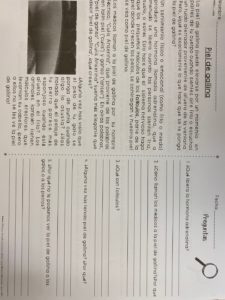
-
Reading with comprehension questions.
-
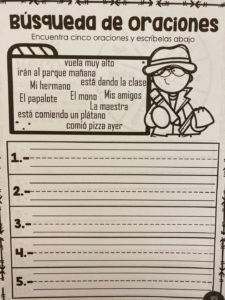
-
Grammar!
-
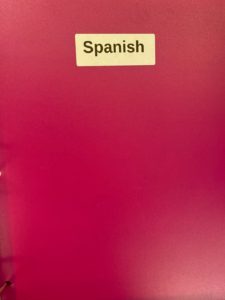
-
Spanish journal
-
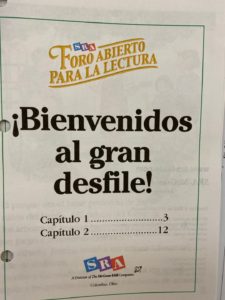
-
Spanish Readers
Las matemáticas
-
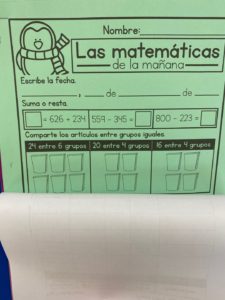
-
Daily review
-
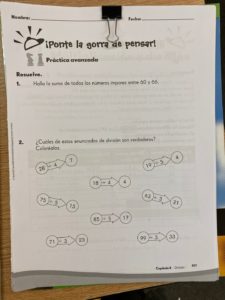
-
Finishing up chapter 8: Division and Chapter 9.
-
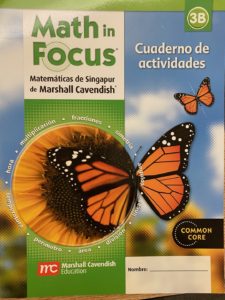
-
Starting workbook B (Don’t worry, I have links to the English version and videos with the instructions all set for Google classroom!)
-
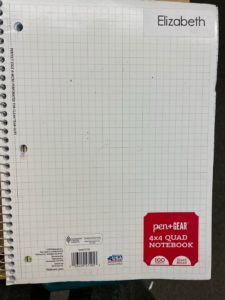
-
Math journal (They should show all their work!)
Science
Jill has some online things she will be posting through Google classroom and communicating through Zoom. We are sending home some seeds though. Please wait for instructions!
History & Geography
-
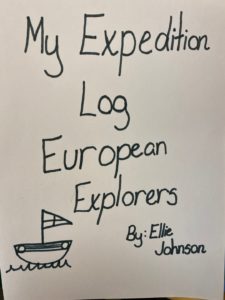
-
They will complete their European Explorers log at home.
-
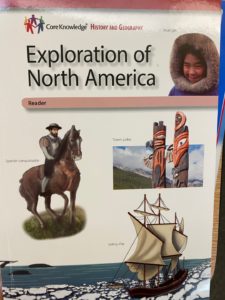
-
Be gentle with our class books. These will need to be returned!
-
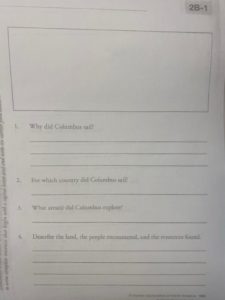
-
Ms. Jill will give more instructions on these pages for the European Explorers Log.
-
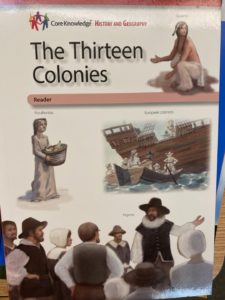
-
Be gentle with our class books. These will need to be returned!
Spelling
-
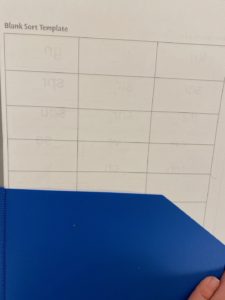
-
Ms. Jill will give you new words via Google Classroom. You will be writing them on these blank sort pages.
-
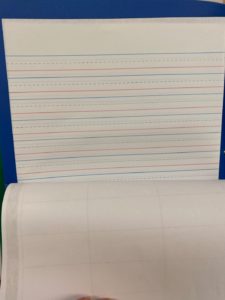
-
Hmmm. We’ll let you know what these handwriting pages are for!
-
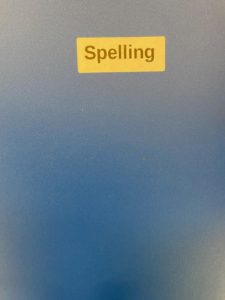
-
These pages are all found in the spelling folder of your big binder. Stay organized!
Music with Ms. Nadia
Hello 2nd and 3rd graders!
Hope y’all are enjoying the sun and making the most of our situation! To continue learning together, each week I will be sending you a music challenge in Google Classroom. There will be prizes!
The first one is already up and ready for you!
Art with Ms. Kelly
ART AT HOME Ideas
Hello Parents and Students! Here are some Art ideas for your very creative students to try at home! Each week I’ll send a Sketchbook Prompt and an Art Project suggestion. There are so many art-related resources online, but here are a few to start with:
WEBSITES:
www.Artprojectsforkids.org (many free “how to draw” ideas)
www.Cassiestephens.blogspot.com (lots of creative, fun lessons)
www.Deepspacesparkle.com (some free lessons and an “Emergency Sparkle Kit”)
Most Art Museums have wonderful websites for children!
SKETCHBOOK PROMPT:
You can make a simple sketchbook from copy paper or use a folder to collect various types of paper you already have. Write your name and date on each page!
First Day of Spring: Find a sign of spring in your yard or on a walk, such as a flower, a weed (dandelions!), a leaf, a branch with leaves or flowers, etc.
Observe it closely: What lines, shapes, colors and textures do you see? Look at the object from different angles. Make a pencil drawing of this object. Fill the page by making several drawings of the object. Challenge: Try drawing the object without lifting your pencil from the paper!
ART PROJECT:
Choose one drawing from your sketchbook and enlarge it to fill an entire page. (If possible, ask your parent if you can use their phone camera to zoom in on the object). Using a pencil, draw the outline of your leaf or flower or branch so that it touches all 4 sides of the paper. Trace over your pencil drawing with a black crayon. Then add color with crayons, markers, and/or watercolors if you have them. Observe again the colors in your object: how many different greens or yellows or browns do you see? Can you make different colors by layering crayons, or layering marker over crayon? Can you add texture by combining crayon and marker?
Look at the artwork of Georgia O’Keefe for inspiration!
by Jill & Sarah | Mar 13, 2020 | 2nd/3rd Grade News
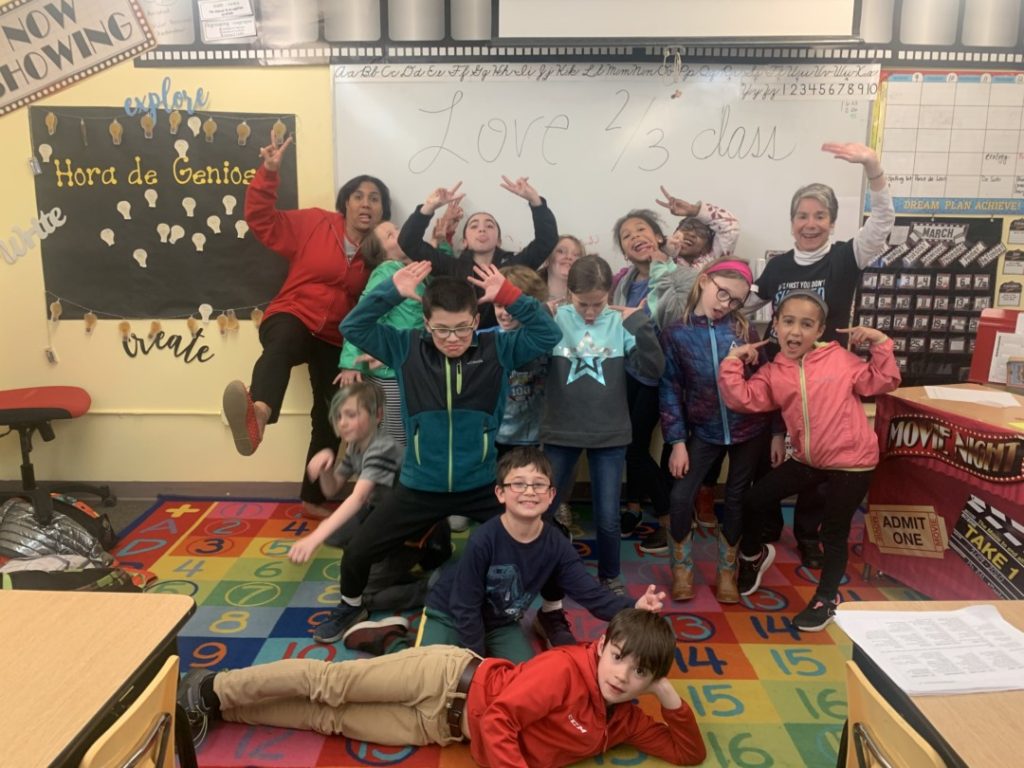
La Lectura
This week the students read: Las Pecas independently and then as a whole group.
Our objectives:
- reader review
- understand meanings of new vocabulary words
- understand fact verses fiction.
- identify articles and use them correctly in written sentences
- Use comprehension strategies such as summarizing, and predicting to construct meaning from the text during our first read
Las matemáticas
Students worked on their long division skills and had the opportunity to practice their division skills throughout the week with their “Pretzel Math” game from last week. They REALLY need to be strong on all their multiplication facts for division!
Science
this week our objectives were to:
*Describe ecology is the study of relationships between living things and their environment
*Describe and provide an example of a habitat
*Explain why certain organisms live in certain habitats and how they adapt to those habitats
*Describe and provide an example of an ecosystem
*Describe what happens in a food chain
*Identify the three essential parts of a food chain: producers, consumers, and decomposers
*Sequence of food chain of two or more trophic levels
History and Geography
This week our primary focus objectives were to:
*Describe North America is geography, including the location of the west Indies, Puerto Rico, Cuba, Caribbean Sea, and the Gulf of Mexico.
*Explain Columbus is explorations.
*Describe Ponce de Leon’s early exploration of Florida.
*Understand the meaning of the vocabulary: space, colony, empire, expedition, and settlement.
*Describe Hernando De Soto.
Summarize the explorations of De Soto.
Here are the delicious recipes of the Native American foods Bryce brought in for his presentation: venison stew and bannock bread
The 2nd/3rd grade class asked that I share the traditional recipe I found for Algonquin stew. The Algonquin Stew was used for Moose, elk, deer, and rabbit meat cuts.
Ingredients:
• Moose, venison, elk stew cuts. (you can buy stew cuts of elk and venison at New Seasons)
· 1 Onions
· 3 Carrots
· 1 Turnips
· 3 red Potatoes
· 1/2 bag of frozen sweet Corn or 1 can of sweet corn
• Flour (Gravy Mix) (corn starch is a good substitute too)
• Salt & Pepper (I used alder smoked sea salt. Check Amazon)
Directions:
Cut up in smallish quarters; potatoes, turnips, carrots and onions)
Put the meat and onions in a stew pot and let boil for 15 minutes (If using a Crock Pot, sauté onions and meat with a little smoked olive oil. I think any oil would do then I added to Crock Pot)
Add carrots, turnips, potatoes to Crock Pot, salt and pepper to taste. Add water to almost cover the ingredients in the pot and set Crock Pot to the High setting for 4 hours **or add carrots and turnips and let boil for 15 minutes or more in stew pot.
If using a stew pot NOW add potatoes, salt and pepper to taste and let boil for another 30 minutes
If using Crock Pot, add corn about 45 minutes before time is up ** and if using a stew pot -Add frozen or canned sweet corn and boil for 15 minutes
Mix ¾ cup of water and 3 tablespoons of flour in a cup (or cornstarch) and add gravy mixture to stew pot and boil for 5 minutes and serve ** if using a crock pot, about 30 minutes before you are ready to serve
Bannock Bread (can buy Red Corn Authentic Native American Fry Bread Mix on Amazon too)
· 4 cups all-purpose flour
· 1/2 teaspoon salt
· 1 tablespoon baking powder
· 1 1/2 cups warm water (110 degrees F/45 degrees C)
· 4 cups shortening for frying
Directions
Combine flour, salt, and baking powder. Stir in 1 1/2 cups lukewarm water. Knead until soft but not sticky. Let stand for 30 minutes to an hour. Shape dough into balls about 3 inches in diameter. Use flour on board and hands to make it go easier. Flatten them and pull until like a pancake size.
Fry one at a time in 1 inch of hot (375-380 degrees) Canola or vegetable oil, turning to brown on both sides. Drain on paper towels.
Bonne Appetit! Enjoy!
Character Education with Dr. Torres
Feelings Identification and Modification:
Kids can have a tough time knowing how to deal with different feelings in appropriate ways. Understanding and appreciating others’ feelings can be difficult, too. This week’s activities focused on helping students identify and deal appropriately with their feelings and their classmates’ feelings. They participated in a game called, “Guess the Feeling,” in which one student picked a card with a feeling listed on it. They then tried to get the class to guess the feeling by expressing it. This activity helped students both recognize different feelings in oneself and others, and provided an opportunity to discuss moments of misperceptions or mis-cueing of feelings (I.e., trying to express sadness, but others’ interpreting it as anger). We also talked about what makes us feel good and created a “Feel Good Journal” as a coping tool.
This class also worked on identifying and discussing how they’d feel if they were involved in a variety of scenarios provided by the teacher. This included:
-Demonstrating the ability to listen to and appreciate classmates’ opinions and feelings
-Practicing reflecting skills to ensure they truly heard and understood the other’s feeling statements.
Objectives:
Through this lesson, students will:
• Comprehend concepts related
to health promotion and disease prevention to enhance health.
• Demonstrate the ability to use interpersonal communication skills to enhance health and avoid or reduce health risks.
• Demonstrate the ability to use decision-making skills to enhance health.
• Demonstrate the ability to advocate for personal, family, and community health.
by Jill & Sarah | Mar 6, 2020 | 2nd/3rd Grade News
La Lectura
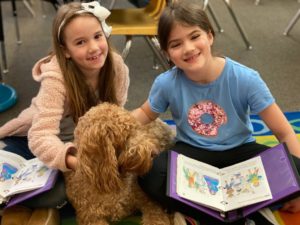
Partner reading …with a special guest.
This week we read a story from the Imaginación theme: Roxaboxen. This realistic fiction piece tells about Roxaboxen, a magical place created by children who spent many hours devising all the rules and regulations of Roxaboxen. Everyone has plenty of money, transportation, and all the ice cream they can eat. Roxaboxen is such a special place that none of the children will every forget it – no matter where they move or how old they become.
Keys points of realistic fiction include:
- The characters behave as people do in real life.
- The setting of the story is a real place or could be a real place.
- The events in the story could happen in real life.
Grammar: This week we learned about the strength of words and the tone we use in our writing. We also talked about articles which accompany nouns. Articles indicate gender and number: el, la, los, las, lo, un, unos, una, unas.
Las matemáticas
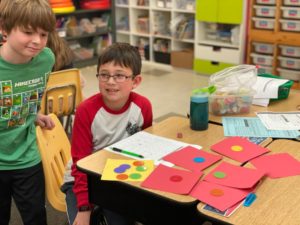 We dove right in with our unit on Division this week. Students learned that the answer to division problems is the quotient / cociente. Sometimes we are not able to divide things equally and there are some leftovers. The leftovers are called the remainder/ residuo. We talked quite a bit how we use our multiplication fact knowledge to help us with division. Students should continue practicing ALL their math facts with either flashcards or www.mathfactspro.com so they stay strong on ALL their facts and not just their current timed test facts.
We dove right in with our unit on Division this week. Students learned that the answer to division problems is the quotient / cociente. Sometimes we are not able to divide things equally and there are some leftovers. The leftovers are called the remainder/ residuo. We talked quite a bit how we use our multiplication fact knowledge to help us with division. Students should continue practicing ALL their math facts with either flashcards or www.mathfactspro.com so they stay strong on ALL their facts and not just their current timed test facts.
We introduced a division game on Friday where students play in pairs. They have 6 colored squares to share. They each have a yellow square for their remainders. Pairs started with 20 chips, rolled a dice to determine how many colored squares they would divide by. For example: They rolled 3 so they are going to divide the 20 chips into 3 equal groups. Uh-oh. There are 6 in each group but 2 left over. The two left over chips go into the remainder/residuo pile. The next player now starts with the 18 chips, rolls the die to determine how many groups to divide by, and so on. They play until there are no more chips left. The winner is the student with the most chips in their remainder/residuo. They keep track on a chart: 20 chips, 3 groups, remainder 2 : 20 ÷ 3 = 6 r2
Science
Stay tuned! We will be starting a unit on ecology shortly!
History & Geography

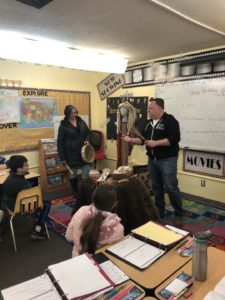
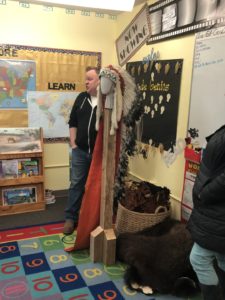
by Jill & Sarah | Feb 28, 2020 | 2nd/3rd Grade News
La Lectura
We worked on conjugating verbs into the Vosotros and the Ustedes form. The vosotros is the 2nd person plural form of verbs but is very unfamiliar in our classrooms, as we all use the ustedes form instead of vosotros. The vosotros form is only used in Spain and Equatorial Guinea, in an informal way, and Ustedes in a formal way. In Latin America, people do not generally use the Vosotros form of the verb. We are teaching it so the students are aware of it’s existence. We do occasionally hear it in songs or books. The Ustedes form is the 3rd person plural and is also mostly used i
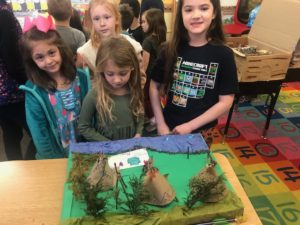
Sharing H&G projects with other classes.
n place of the 2nd person plural.
Students received their new spelling lists on Tuesday. They will have their next Spanish spelling test on Friday, March 6th.
We also worked on categorizing groups of words after finding similarities and differences. We did this using vocabulary from last week’s story: The Emperor who wore no clothes.
Las matemáticas
The kiddos did a great job with multiplication and division word problems this week. We really tried to visualize the story problems to help us truly understand which function we needed to use. I saw lots of light bulbs going on this week! Aha! Students took their end of unit test on Thursday and did a fantastic job!
Next week we will jumped right into our new Division chapter. What does this mean for our 2nd/3rd graders?
Big Idea: There can be remainders when dividing to make equal groups or when sharing equally.
- Use related multiplication facts to divide.
- Use patterns to divide multiples of 10 and 100.
- Divide a 1-digit number or a 2-digit number by a 1-digit number with or without remainder.
- Use different strategies to identify odd and even numbers.
- Use base-ten blocks and place value to divide 2-digit numbers without regrouping or remainders.
- Use base-ten blocks and place value to divide 2-digit numbers by a 1-digit number with regrouping, with or without remainders
- Thinking Skill:
- Identifying patterns and relationships
- Problem Solving Strategey:
- Key Visuals/Activities:
- Students use related multiplication facts to divide. They apply the inverse relationship of multiplication and division to write division statements from the corresponding multiplication sentence.
- Students learn that in division there is always a quotient and possibly a remainder.
- Students learn the steps of vertical division to divide with or without regrouping or a remainder.
Chapter Vocabulary:
- quotient- the answer in a division problem,
- remainder-the number leftover when a number cannot be evenly divided,
- even numbers- when an even number is divided by 2 there will not be a remainder,
- odd numbers-when an odd number is divided by there will be a remainder of 1.
History & Geography
I could not be more proud of the hard work these kids put into their reports, projects and presentations. Everyone did a fabulous job and we all learned new information about the selected tribes! Way to go kiddos!
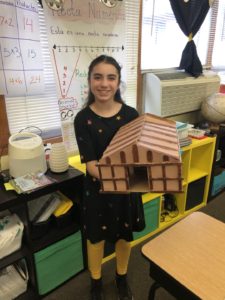
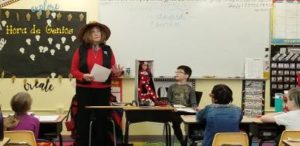
Art with Ms. Kelly
Folk Art Flower Paintings:
Goals: Learn about self-taught African American artists Clementine Hunter and Horace Pippin
“Draw” with black paint – no pencil!
Use simple shapes similar to folk artists
Try different art media: tempera paint, watercolors, and chalk pastel
These beautiful, vivid flower paintings and drawings have been on the bulletin board at school. The students were so prolific that they had enough flower art to make beautiful Valentine cards!
Weaving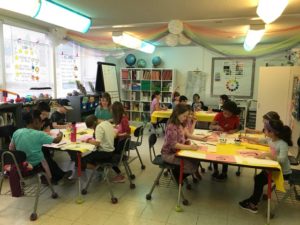
Learn weaving vocabulary: loom, warp threads, weft threads
Read A Goat in the Rug about a Navajo weaver
Create a small woven wall hanging
The students are doing a wonderful job on their weavings, and we plan to finish them next week.
Music with Ms. Nadia
Goodbye to February and Happy March! What better way to celebrate than on a bicycle built for two?
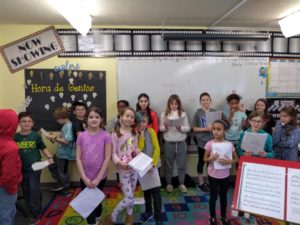 This past month has been an introduction to the choir! Not only are we learning the song A Bicycle Built for Two, the class is learning how to stand in choir formation, how to read sheet music, and fun ways to warm up our voices! Vocal warmups include One Bright and Sunny Morning, Bum-Biddily, 121, and sirens.
This past month has been an introduction to the choir! Not only are we learning the song A Bicycle Built for Two, the class is learning how to stand in choir formation, how to read sheet music, and fun ways to warm up our voices! Vocal warmups include One Bright and Sunny Morning, Bum-Biddily, 121, and sirens.
Students are also learning how to draw a treble clef and the names on of the notes on the staff. We turned the C Scale (C, D, E, F, G, A, B, c) into a secret code. The class took turns making words by writing notes on the staff, while everyone else had to guess the word. The process was then reversed, and students had to look at a word and figure out how to write the notes. Favorite words include “EGG”, “DAB”, and “GABE”. It’s a fun game to try at home!
Other highlights include weekly hangman, an Aaron Copland vs Tchaikovsky listening game, and Toystore.
by Jill & Sarah | Feb 22, 2020 | 2nd/3rd Grade News
-
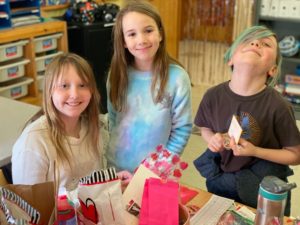
-
Happy Valentine’s Day!
-
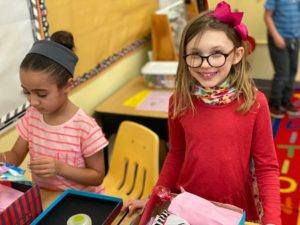
-
Valentine exchange
-
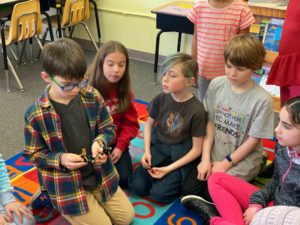
-
When all the individual pieces are put together they make something special. Great idea!
La lectura
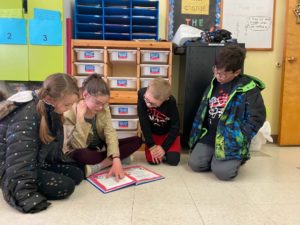
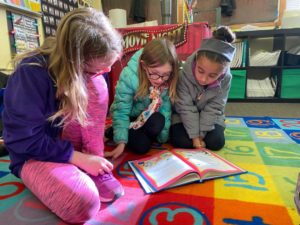
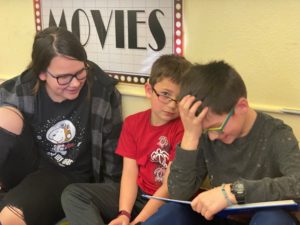 We had a great time with our story of the week: The Emperor and His New Clothes. The students did a preview, picture walk-through and then did their first reading in partners with a 4th/5th grade helper. This was so great and something we will do again soon.
We had a great time with our story of the week: The Emperor and His New Clothes. The students did a preview, picture walk-through and then did their first reading in partners with a 4th/5th grade helper. This was so great and something we will do again soon.
Students worked on their story recall by illustrating what they remembered happening at the beginning, middle and end of the story. We then re-read the story as a class, being sure to discuss more advanced vocabulary and to work on our visualizing strategy. The students then, once again, illustrated and wrote sentences describing their new understanding of the story for the beginning, middle and end. Reading stories more than once really does make a difference in our comprehension!
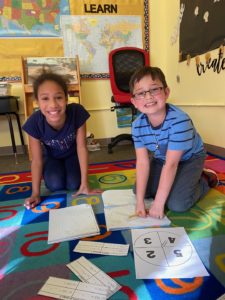 Las matemáticas
Las matemáticas
We had a great week working on our multi-digit multiplication facts. We are really working to understand the why/how of regrouping in multiplication. We worked on this using various methods throughout the week.
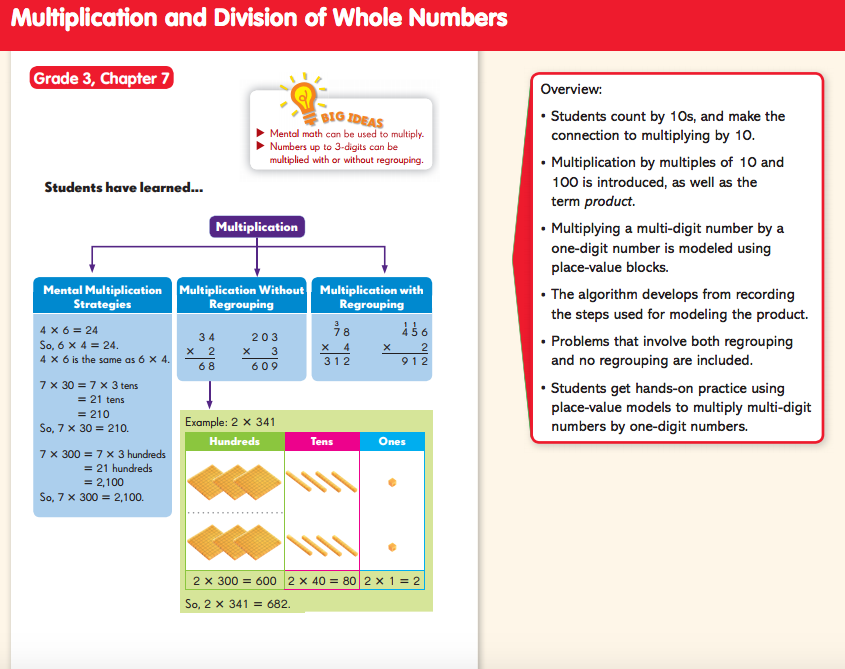
History & Geography
This week we spent much of our time wrapping up our Native American Tribe reports. Each student should have brought home their final report so they are able to practice their oral presentation at home.
We will have our presentations next week, Monday-Friday. Parents are welcome to stay for the presentations. We will do them in the first hour of our morning, so parents can stay at drop off time on the day of the their child´s presentation. Students can bring their home project to class on the day of their report, or bring it on Monday if it is finished and ready.





















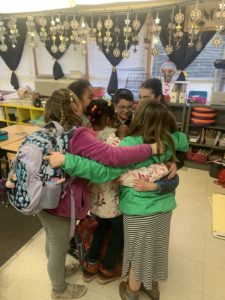

 We dove right in with our unit on Division this week. Students learned that the answer to division problems is the quotient / cociente. Sometimes we are not able to divide things equally and there are some leftovers. The leftovers are called the remainder/ residuo. We talked quite a bit how we use our multiplication fact knowledge to help us with division. Students should continue practicing ALL their math facts with either flashcards or www.mathfactspro.com so they stay strong on ALL their facts and not just their current timed test facts.
We dove right in with our unit on Division this week. Students learned that the answer to division problems is the quotient / cociente. Sometimes we are not able to divide things equally and there are some leftovers. The leftovers are called the remainder/ residuo. We talked quite a bit how we use our multiplication fact knowledge to help us with division. Students should continue practicing ALL their math facts with either flashcards or www.mathfactspro.com so they stay strong on ALL their facts and not just their current timed test facts.






 This past month has been an introduction to the choir! Not only are we learning the song A Bicycle Built for Two, the class is learning how to stand in choir formation, how to read sheet music, and fun ways to warm up our voices! Vocal warmups include One Bright and Sunny Morning, Bum-Biddily, 121, and sirens.
This past month has been an introduction to the choir! Not only are we learning the song A Bicycle Built for Two, the class is learning how to stand in choir formation, how to read sheet music, and fun ways to warm up our voices! Vocal warmups include One Bright and Sunny Morning, Bum-Biddily, 121, and sirens.




 We had a great time with our story of the week: The Emperor and His New Clothes. The students did a preview, picture walk-through and then did their first reading in partners with a 4th/5th grade helper. This was so great and something we will do again soon.
We had a great time with our story of the week: The Emperor and His New Clothes. The students did a preview, picture walk-through and then did their first reading in partners with a 4th/5th grade helper. This was so great and something we will do again soon. Las matemáticas
Las matemáticas